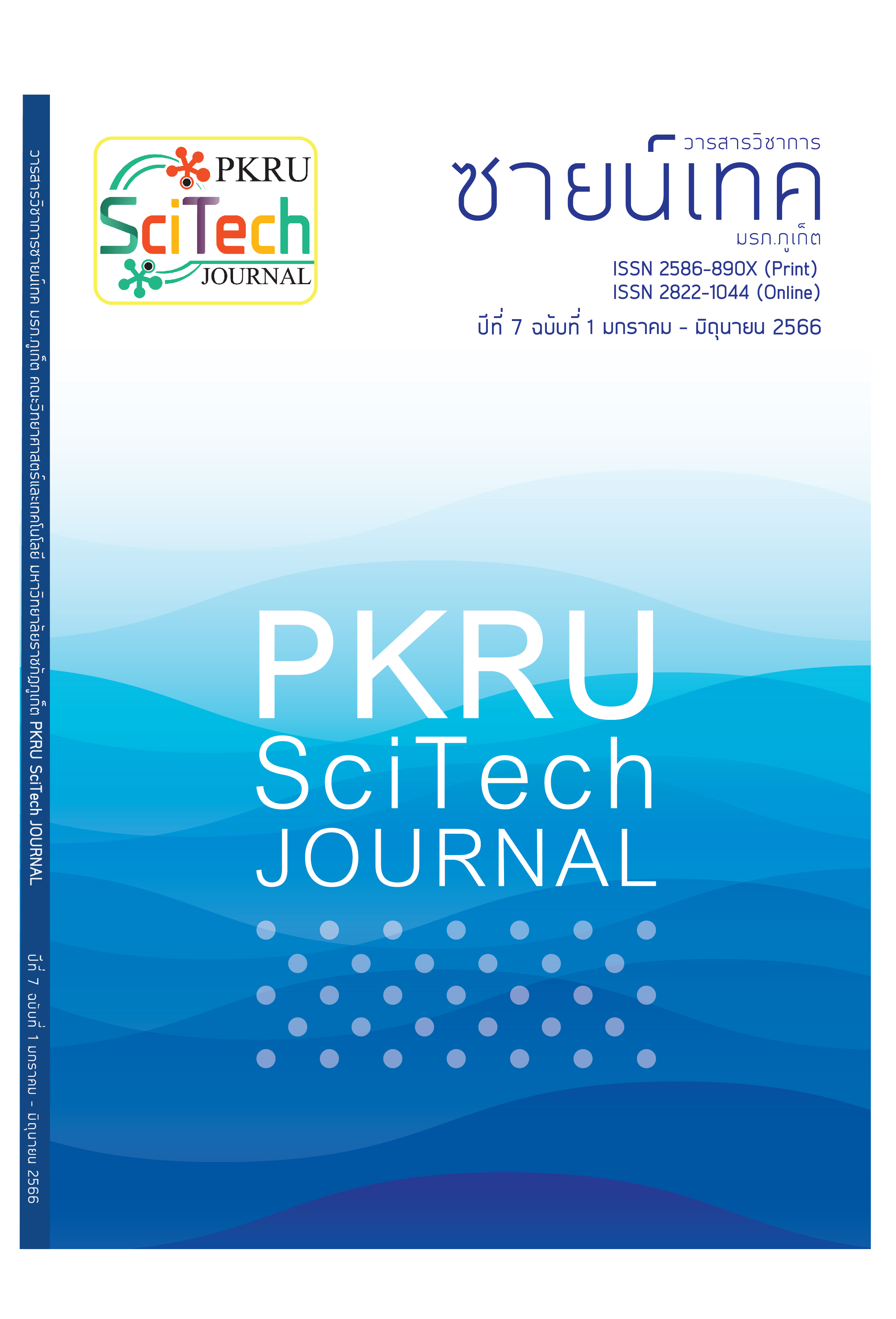Utilization of Paka-Umpoul Defatted Rice Bran Flour in Cookies
Main Article Content
Abstract
This research studied and developed cookie products from Paka-Umpoul defatted rice bran flour partial replacement for wheat flour. The chemical composition of Paka-Umpoul defatted rice bran flour consisted of moisture, protein, fat, ash, carbohydrate, and dietary fiber by 5.69%, 16.07%, 10.80%, 9.92%, 57.52% and 6.66%, respectively, the gamma-oryzanol content was 0.115 mg/100 g and the antiradical activity was 63.69 mg/100 g. Cookie products were prepared in which Paka-Umpoul defatted rice bran flour was substituted for wheat flour at 5 levels of 0%, 10%, 20%, 30%, and 40%, and sensory acceptance was assessed using 30 quasi-trained test subjects. It was found that Paka-Umpoul defatted rice bran flour could be selected as a 40% replacement for wheat flour. The higher substitution with Paka-Umpoul defatted rice bran flour resulted from a higher content of ash and dietary fiber by 2.18% and 2.86%, gamma-oryzanol content of 0.068 mg/100 g, and antiradical activity of 30.75 mg/100 g., lower lightness (L*) values and free water content (aw) was increased from 0.19 to 0.35, and microbial quality was in the Thai industry-standard institute: cookies (TISI.118/2555) that are not more than 1 x 106 log CFU/g.
Article Details

This work is licensed under a Creative Commons Attribution-NonCommercial-NoDerivatives 4.0 International License.
- The original content that appears in this journal is the responsibility of the author excluding any typographical errors.
- The copyright of manuscripts that published in PKRU SciTech Journal is owned by PKRU SciTech Journal.
References
Jiratchaya W, Chaiwat A, Apinya S, Mintra S, Warintorn R, Chanakan P., & Korawan S., (2022). Comparative analysis of nutritional components and phytochemical attributes of selected Thai rice bran. Frontiers in Nutrition, 9, 833730.
Moongngarm, A., Daomukda, N., & Khumpika, S. (2012). Chemical compositions, phytochemicals, and antioxidant capacity of rice bran, rice bran layer, and rice germ. Apcbee Procedia, 2, 73–7.
Issara, U., & Rawdkuen, S. (2016). Rice bran: a potential of main ingredient in healthy beverage. International Food Research Journal, 23(6), 2306-2318.
แผนงานฐานทรัพยากรอาหาร สำนักงานกองทุน สนับสนุนการสร้างเสริมสุขภาพ. (2553). มหัศจรรย์พันธุ์ข้าวพื้นบ้านคุณค่าทางโภชนาการของสายพันธุ์ข้าวท้องถิ่น. [ออนไลน์], สืบค้นจา https://prachatai.com
/journal/2008/09/18027 (14 ตุลาคม 2565).
Garsa, A. (2020). Preparation and nutritional properties of cookies from the partial replacement of wheat flour using pumpkin seeds powder. World Journal of Environmental Biosciences, 9(2), 48-56.
Allen, T. A., Quast, E., Bertran, L. C., & Balny, E. M. (2016). Partial substitution of wheat flour with taro (Colocasia esculenta) flour on cookie quality, Revista de Ciências Exatas e Naturais, 18(2), 202-212.
นวพร ลาภส่งผล นันทิดา บุญเสงี่ยม และ ดวงหทัย ใจเสาร์. (2559). ผลของการทดแทนแป้งสาลีด้วยโปรตีนกากถั่วเขียวต่อคุณภาพของคุกกี้เนย. วารสารวิทยาศาสตร์เกษตร, 47(2)(พิเศษ), 293-296.
Norhidayah, M., Noorlaila, A., & Nur Fatin Izzati, A. (2014). Textural and sensorial properties of cookies prepared by partial substitution of wheat flour with unripe banana (Musa x paradisiaca var. Tanduk and Musa acuminata var. Emas) flour. International Food Research Journal. 21(6), 2133-2139
อริสรา รอดมุ้ย และ อรอุมา จิตรวโรภาส. (2550). การผลิตคุกกี้โดยใช้แป้งข้าวหอมนิลทดแทนแป้งสาลีบางส่วน. วารสารเทคโนโลยีการอาหาร, 3(1), 37-43.
คงศักดิ์ ศรีแก้ว, เฉลิมพร ทองพูน, ธวัชชัย ศุภวิทิตพัฒนา, ปิยวรรณ ศุภวิทิตพัฒนา, และเมธาวนี ประดิษฐ์. (2553). กระบวนการอย่างง่ายในการเพิ่มผลผลิตและปรับปรุงคุณภาพน้ำมันรำข้าวบีบเย็น. วารสารวิจัยเพื่อการพัฒนาเชิงพื้นที่, 2(6), 43-52.
AOAC. (2012). Official method of analysis (19th ed). Washington DC: The Association of Official Analytical Chemists Inc.
Perretti, G., Miniati, E., Montanari, L., & Fantozzi, P. (2003). Improving the value of rice by-products by SFE. Journal of Supercritical Fluids, 26, 63-71.
Kwaw, E., Ma, Y., Tchabo, W., Apaliya, M. T., Wu, M., Sackey, A. S., & Tahir, H. E. (2018). Effect of lactobacillus strains on phenolic profile, color attributes and antioxidant activities of lactic-acid-fermented mulberry juice. Food Chemistry, 250, 148-154.
Ugwuona, F., Ukom, A., Ejinkeonye, B., Obeta, N., & Ojinnaka, M. (2021). Exploring the possibilities of some selected flour blends for the development of bakery products: Comparison with some physicochemical and functional properties of wheat flour. Food Science and Technology International, 29(2), 105-114.
Chopra, N., Dhillon, B. Rani, R., & Singh, A. (2018). Physico nutritional and sensory properties of cookies formulated with quinoa, sweet potato and wheat flour blends. Current Research in Nutrition and Food Science, 6(3), 798-806.
Gani, A., Wani, SM., Masoodi, FA., & Hameed, G. (2012). Whole-grain cereal bioactive compounds and their health benefits: a review. Journal of Food Processing & Technology, 3(3), 1000146.
บุญยกฤต รัตนพันธุ์, วัชระ สิงห์หง, อเนก หาลี, พิมพ์ชนก พริกบุญจันทร์. (2560). การพัฒนาผลิตภัณฑ์คุกกี้จากรำข้าวหอมนิล (หน้า 233-239). ใน การประชุมวิชาการระดับชาติของมหาวิทยาลัยราชภัฏกาญจนบุรี ครั้งที่ 2. กาญจนบุรี.
Gunstone, F. (1996). Fatty acid and lipid chemistry. New York: Chapman & Hall.
วิวัฒน์ หวังเจริญ. (2010). แอคติวิตี้ของน้ำและการศึกษาอายุการเก็บรักษาของอาหารแห้ง. Food, 40(4), 277-281.
Neeta, K., Neelam, K. V., & Priyanka R. (2018). Nutrient composition of full fat and defatted rice bran. Asian Journal of Dairy and Food Research, 37(1), 77-80.
Mishra, N. (2017). Utilization of waste defatted rice bran in formulation of functional cookies and its effect on physiochemical characteristic of cookies. International Journal of Advanced Science and Research, 2(5), 64-6.
Sudha, S., Gopala, K., & Asna, U. (2011). Physio-chemical characteristics of defatted rice bran and its utilization. Journal of Food Science and Technology, 48(4), 478–483.
Kalpanadevi, C., Vasudeva, S., & Subramanian, R. (2018). Influence of milling on the nutritional composition of bran from different rice varieties. Food Science and Technology, 55(6), 2259–2269.
สำนักงานมาตรฐานผลิตภัณฑ์อุตสาหกรรม. (2555). มาตรฐานผลิตภัณฑ์ชุมมชน: คุกกี้ 118/2555. มาตรฐานผลิตภัณฑ์ชุมชน.


